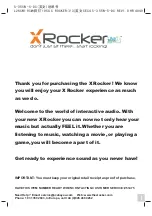
20-11-2009 11 033000=14888C
2. Connect the RCA plugs of this cable to the A/V device you want to transmit the signal
from. Make sure the colours of the plugs and the input connectors match. If the A/V device is
equipped with a SCART connector you can also connect the transmitter using the SCART
adapter labelled ‘TRANSMITTER’.
3. In order to also connect the A/V device to ‘TV1’ (your local TV), insert a Mini -DIN/RCA
cable between the ‘AV OUT’ of the transmitter and your ‘TV1’. If this TV is equipped with a
SCART connector you can also connect the transmitter using the included SCART adapter
labelled ‘AV OUT’.
4. Set to channel selector (A-B-C-D) to A.
5. Insert the plug of one of the power adapters in the ‘DC in’ on the back of the transmitter
and plug the power adapter included into a wall socket (230V-50Hz). Only use the adapter
provided!
6. Turn the On/Off switch to ‘ON’.
7. Place the transmitter in an easy accessible spot with enough space around it. Aim the
inside of the dish antenna at the location of the receiver.
8. Put the side antenna in an upright position.
9. When you want to connect a second A/V device, please repeat steps 1 to 3, and then turn
the On/Off switch to ‘ON’ again.
Video signal and S-VIDEO signal
It is not possible to connect a A/V device via S-VIDEO. When you have a A/V device which
only has S-VIDEO output, (a S-VIDEO connection is a small round mini DIN plug with 4 pins) you
can use a S-VIDEO to Composite video adapter (product code: SVHS-CV).
6. SETTING UP THE RECEIVER.
See figure 8 on page 7.
1. Connect the Mini-DIN/RCA cable to the outputs at the back of the receiver.
2. Plug the other end of this cable into the A/V input of TV2. Make sure the colours of the
plugs and the input connectors match. If the TV is equipped with a SCART connector then
you can also connect the transmitter using the included SCART adapter labelled ‘RECEIVER’.
When your TV does not have a SCART connection, you can also connect the receiver to your
TV via an antenna cable. To do this, connect the VIDEOLINK to your TV via the RF output and
set the TV to channel 36.
3. Insert the power adapter plug into the DC input on the back of the receiver and plug the
power adapter into a wall socket (230V-50Hz). Only use the adapter provided!
4. Turn the On/Off switch to ‘ON’.
5. Set the channel selector (A-B-C-D) to A.
6. Place the receiver in an easy accessible spot with enough space around it, e.g. on top of
the TV. Point the inside of the dish antenna at the location of the transmitter.
7. Put the side antenna in an upright position.
7. SETTING UP THE IR EXTENDER FEATURE.
See figure 7 on page 7.
1. Connect the IR Extender included to the input at the back of the transmitter.
2. Remove the protective label of one of the IR emitters. Place this IR emitter on the IR window
of the A/V device you want to control. Fix the emitter very lightly. Before fixing the IR emitter
firmly you are advised to check if the extender works properly. Therefore point your own
remote at the window on the front of the receiver and press some of the channel choose
buttons. If the channel does not change, the IR emitter may not be fixed in the right position.
Содержание XDOM VL58 - PRODUCTSHEET
Страница 2: ...20 11 2009 2 033000 14888C...
Страница 7: ...20 11 2009 7 033000 14888C Figure 7 Figure 8...
Страница 8: ...20 11 2009 8 033000 14888C...
Страница 72: ...20 11 2009 72 033000 14888C www ebodeelectronics eu...












































